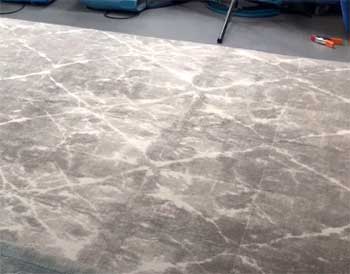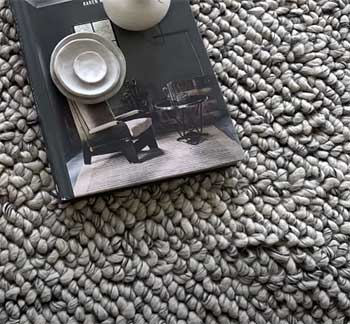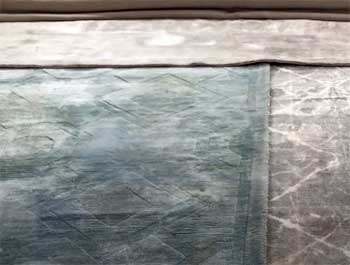Rugs are a great way to add comfort, warmth and style to any room. When it comes to choosing between natural and synthetic fibers for rugs, two of the most popular options are viscose and wool. But which one is right for you?
Viscose and wool each have their own sets of pros and cons when it comes to performance, feel, maintenance and cost. Read on as we explore the key differences between viscose and wool rugs to help you decide which is better suited for your home.
A Brief Comparison Table
| Aspects | Viscose | Wool |
| Feel | Very soft, silky | Loftier, more texture |
| Durability | Low, shows wear quickly | High, lasts decades |
| Stain Resistance | Absorbs spills easily | Naturally stain resistant |
| Allergies | Hypoallergenic | May trigger allergies |
| Maintenance | Easy, vacuum only | Requires professional cleaning |
| Cost | Lower | Higher |
| Environmental Impact | Uses heavy chemicals | Renewable, biodegradable |
| Aesthetics | Wide range of colors | More limited, natural texture |
| Best Uses | Bedrooms, low traffic areas | Hallways, high traffic areas |
What Is Viscose?

Viscose is a man-made fiber created from cellulose.
To make viscose, wood pulp is chemically treated to produce a solution that is then extruded through tiny holes to form long threads of fiber.
The origins of viscose date back to the late 1800s, when it was first developed as an alternative to silk.
By the mid-1900s, viscose became a popular choice for rugs and carpeting.
Today, viscose is prized in rugs for its soft, silky feel. It’s smooth to the touch and has a fluid drape. Viscose also readily takes dye, allowing for vibrant colors and patterns.
On the downside, viscose lacks the resilience and durability of natural fibers. It can crush easily under heavy foot traffic and is prone to shedding. Over time, viscose rugs tend to lose their luster.
What Is Wool?
Wool is a natural protein fiber that comes from sheep. It’s derived from the coat of sheep and then cleaned, carded and spun into yarn.
Wool has been used for rugs and textiles for centuries. It’s known for its warmth, comfort and durability. The fibers have a natural crimp that provide loft and resilience.
Wool is also naturally stain-resistant, fire-resistant and static-resistant. It’s moisture wicking, which allows it to absorb up to 30% of its weight in water without feeling damp. Wool rugs are soil and dirt resistant too.
On the downside, wool is prone to fading when exposed to direct sunlight. It can felt or shrink when washed improperly. Wool rugs also require more specialized cleaning.
Key Differences
Key Differences Between Viscose And Wool Rugs
Now that we’ve covered the background of each fiber, let’s look at how viscose and wool rugs compare across some key factors:
Feel and Comfort
- Viscose – Has a very soft, silky feel. Drapes fluidly.
- Wool – Provides comfortable warmth. Has natural loft and cushioning.
While viscose is silky smooth, wool offers more loft and structure. Wool resists flattening from use better than viscose.
Durability
- Viscose – Susceptible to crushing, matting and shedding. Loses luster over time.
- Wool – Extremely durable and resilient. Withstands heavy foot traffic for years.
Wool is the clear winner when it comes to durability. Quality wool rugs can last for decades or even generations when properly cared for. Viscose begins showing wear much sooner.
Stain Resistance
- Viscose – Prone to staining. Spills and spots sink in quickly.
- Wool – Naturally resistant to stains. Spills can often be blotted up.
Wool’s protective outer layer makes it able to repel liquids. Viscose acts like a sponge, readily absorbing spills.
Allergies
- Viscose – Hypoallergenic and doesn’t harbor allergens.
- Wool – May trigger allergies for those sensitive to wool and lanolin.
For those with wool allergies or sensitivities, viscose is the safer choice. It doesn’t contain any allergens.
Maintenance and Care
- Viscose – Requires only basic vacuuming. Gentle cleaners must be used.
- Wool – Attracts more dirt and requires specialized cleaning.
Viscose is easier to care for overall. But it also shows dirt, stains and footprints much more readily than wool.
Cost

- Viscose – Typically more affordable than wool rugs.
- Wool – Usually costs more than synthetic fibers like viscose.
Viscose provides a less expensive alternative to premium wool rugs.
However, the upfront savings may be negated by viscose’s shorter lifespan.
Environmental Impact
- Viscose – Made from renewable wood pulp, but uses heavy chemicals.
- Wool – Biodegradable and renewable. Considered environmentally friendly.
Wool is the more eco-friendly choice given its biodegradable nature and lack of chemical processing. Viscose production involves toxic chemicals like carbon disulfide.
Aesthetics
- Viscose – Available in a wide range of colors and prints.
- Wool – Provides nice depth and texture. More limited color options.
Those wanting a wide spectrum of colors and designs may prefer viscose. Wool makes up for its more limited color palette with beautiful natural texture.
Best Uses for Each Fiber
Now that you know the primary differences between viscose and wool, let’s look at which rooms and applications each fiber is best suited for.
Viscose Rugs Work Best In:
- Low traffic areas like bedrooms
- Rooms with lots of natural light
- Spaces where rug will be vacuumed frequently
- Homes with pets or kids prone to create stains
The soft feel of viscose is wonderful for bedrooms. But be prepared to clean spills immediately before they set in. Rotate your rug periodically to minimize uneven wear.
Wool Rugs Work Best In:
- High traffic areas like hallways and living rooms
- Spaces that will get heavy day-to-day use
- Areas exposed to moisture like kitchens and mudrooms
- Homes with people sensitive to allergens
Wool is extremely durable, making it a top choice for well-used spaces. Its natural resistance to moisture also makes it a smart option for kitchens and entryways.
Buying Considerations
Here are a few things to keep in mind when shopping for viscose or wool rugs:
- Construction – Look for tightly woven rugs with high knot counts for better durability and fewer shedding fibers. Hand-knotted rugs are highest quality.
- Pile height – Choose low pile for high traffic areas. High pile is more plush but shows footprints and vacuum marks.
- Backing material – Wool or latex backings help rugs lay flat and stay in place. Avoid rubber which can discolor over time.
- Dyes – Wool that is solution-dyed will have superior color fastness and withstand light exposure better.
- Sustainability certifications – Wool rugs may have certifications indicating humanely raised sheep and eco-friendly processing.
- Return policy – Buy from retailers that allow returns in case rug doesn’t meet expectations once unrolled.
Which Should You Choose?
Now that you know the pros and cons of viscose and wool, let’s summarize the key reasons to choose each fiber:
Choose viscose if you want:

- A soft, silky rug at an affordable price
- Vibrant colors and varied patterns
- Easy maintenance with basic vacuuming
- Hypoallergenic flooring
Choose wool if you want:
- Superior durability that lasts for years
- Eco-friendly flooring made from a natural fiber
- Stain and moisture resistance
- A rug that holds up to heavy use
For high-traffic areas, wool is often the best choice thanks to its resilience. But for low-use spaces where style trumps longevity, a viscose rug can be a budget-friendly option.
Consider your needs for comfort, maintenance, and decor when deciding between viscose and wool for your home.
Frequently Asked Questions (FAQ)
Viscose is not better than wool overall. Wool outpaces viscose in durability, stain resistance, and eco-friendliness. However, viscose beats out wool when it comes to affordability and color/pattern options.
Viscose rugs lack the resilience of wool and show wear and tear much faster. They are prone to shedding, matting down, staining, and crushing. Viscose also loses its luster over time and needs to be cleaned more gently.
Viscose is good for rugs in low-traffic areas where durability is not a top concern. Its soft feel and wide range of colors and patterns make it popular for bedrooms, though it requires more frequent vacuuming. Heavily used spaces are better served by wool or synthetic rug fibers.
Wool and viscose rugs have very different durability levels. Wool is extremely durable and can withstand decades of heavy foot traffic with minimal wear when properly cared for. Viscose rugs show signs of wear much faster and begin to deteriorate after just a few years.
The Takeaway
Viscose and wool each have their advantages and disadvantages when used in rugs. Wool prevails when it comes to longevity and performance. But viscose offers an attractive softness and more budget-friendly option.
Think about the location of your new rug, cost considerations, and your own priorities for feel, care, and decor. This will help you decide whether the natural durability of wool or the delicate softness of viscose is right for your home.
With some smart shopping, you can find the perfect rug fiber to suit your lifestyle and space.
